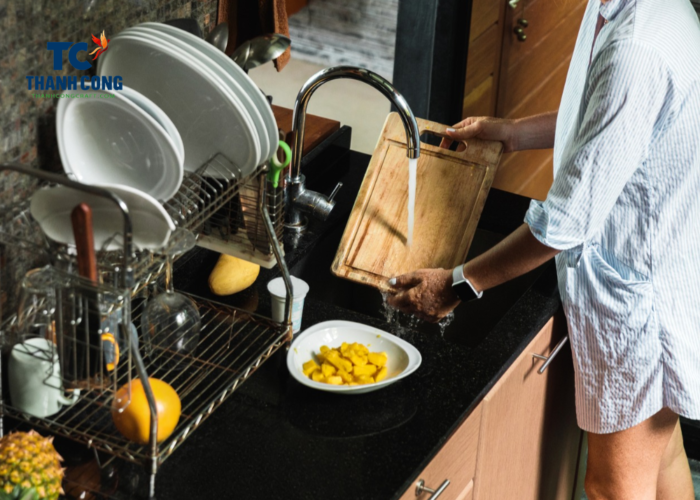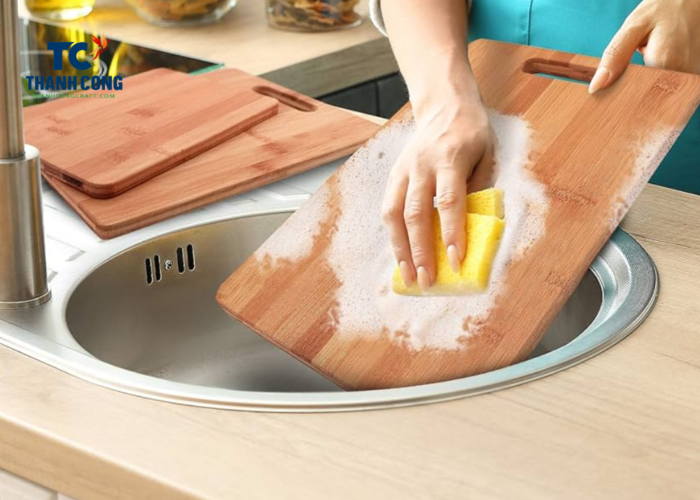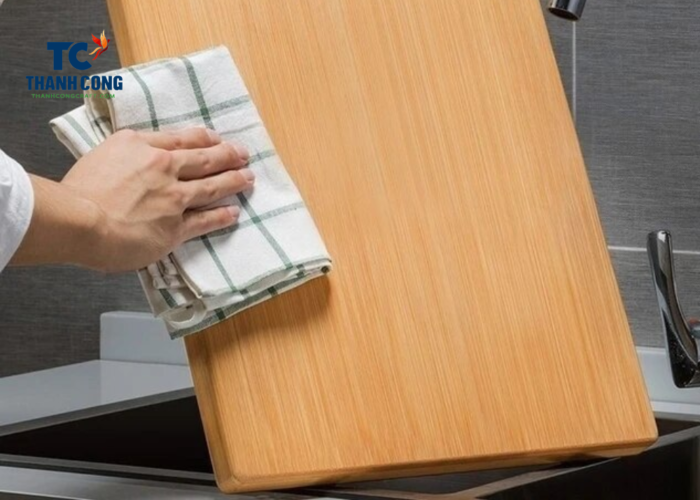Bamboo cutting boards are essential tools in the kitchen, but their longevity and hygiene depend on proper care. Are you familiar with the correct way to clean bamboo cutting boards? In this article, we will teach you on how to clean bamboo cutting board effectively and safely, ensuring they remain a reliable and healthy kitchen companion.
1. How to clean bamboo cutting board?
Bamboo is a durable and environmentally friendly material, often used to make cutting boards. However, to preserve the bamboo cutting board for a long time and safely, you need to pay attention to the proper cleaning and maintenance. Here are the steps to clean the bamboo cutting board effectively:
- Step 1: Rinse Immediately After Use:
After using the bamboo cutting board, rinse it immediately under warm running water to remove any food particles and debris. Avoid using hot water, as it may cause the bamboo to crack.

- Step 2: Prepare a Cleaning Solution:
Mix a small amount of dish soap or mild liquid detergent with warm water in a basin or sink. Use a ratio of about 1 teaspoon of soap to 1 quart of water.

- Step 3: Scrub with a Soft Brush or Sponge:
Dip a soft brush or sponge into the soapy water and gently scrub the entire surface of the bamboo cutting board. Pay special attention to areas with visible stains or food residues.
- Step 4: Rinse Thoroughly:
Rinse the cutting board thoroughly with warm water to remove soap, lemon, and salt residues. Ensure that all cleaning agents are completely washed away.
- Step 5: Dry the Board:
Pat the bamboo cutting board dry with a clean, dry cloth or paper towels. Ensure it is completely dry to prevent the growth of mold or bacteria.

1.1 How to remove stains from bamboo cutting board?
Bamboo is a durable and environmentally friendly material, widely used in products such as cutting boards, plates, spoons, forks, etc. However, bamboo can also turn yellow or get dirty if not properly cared for. To remove stains from bamboo cutting boards, you can apply some of the following methods:
- Use white vinegar: White vinegar has antibacterial and cleaning properties. You just need to dilute white vinegar with water in a 1:1 ratio, then wipe lightly on the surface of the bamboo cutting board. Let the vinegar soak in for 15 minutes, then rinse the board with clean water and dry it.
- Use salt and lemon: Salt and lemon also have deodorizing, whitening and antibacterial effects. You can sprinkle salt on the surface of the bamboo cutting board, then rub lightly with half a lemon. Leave the salt and lemon mixture to work for 20 minutes, then rinse the board with clean water and dry it.
- Use baking soda: Baking soda is a natural and safe cleaning agent. You can mix baking soda with water into a thick paste. Let the baking soda mixture soak in for 30 minutes, then rinse the board with clean water and dry it.
- Sanding bamboo cutting board: To sand a bamboo cutting board, work along the grain to prevent splintering, applying even pressure with a sanding block or sandpaper. Concentrate on areas with scratches or stains, continuing until the surface feels smooth. Optionally, apply a thin layer of food-grade mineral oil for moisture and protection. Allow the cutting board to air dry thoroughly before reuse.
1.2 How to clean bamboo cutting board raw chicken?
Bamboo is a durable and environmentally friendly material, often used to make cutting boards. However, when cutting raw chicken on a bamboo board, you need to pay attention to hygiene and disinfection to avoid the risk of infection. Here are some simple steps to clean the bamboo board after cutting raw chicken:
Rinse the bamboo board under warm water, using soap or mild dishwashing liquid to remove the chicken pieces and grease on the surface. Avoid soaking the board in water for too long as it can cause bamboo to crack or warp.
After rinsing, dry the bamboo board with paper towels or a clean cloth. Place the board on a flat surface and let it air dry completely. Do not place the board near heat sources or direct sunlight as it can cause bamboo to deform.
1.3 How to clean bamboo cutting board with baking soda?
Baking soda is a natural cleanser, capable of deodorizing, killing bacteria and removing stains on the surface of the cutting board. To clean bamboo cutting boards with baking soda, you need to prepare the following ingredients: Lemon half, fine salt, coarse sea salt, baking soda (optional).
- Step 1: Wash Your Bamboo Cutting Board
The process of cleaning a bamboo cutting board is akin to cleaning a wooden or plastic one. Initiate by washing away any residual food prep remnants. Utilize gentle soap and water, ensuring a thorough rinse.
- Step 2: Squeeze Lemon Juice
Pat the board dry with a clean cloth, then liberally squeeze the juice of half a lemon onto the bamboo surface. Retain the lemon rind for later scrubbing. Ensure the juice uniformly covers the entire board.
- Step 3: Add Salt to Cutting Board
Apply a blend of fine and coarse salt to the board, adding a dash of baking soda if preferred. While optional, baking soda enhances stain removal by reacting with the lemon’s acidity. The combination of fine and coarse salt aids in scrubbing grime from even the smallest crevices.
- Step 4: Scrub the Bamboo Cutting Board
Employ the lemon rind as a scrubbing tool. Scrub gently in circular motions until no visible stains remain. If cleaning multiple boards, segregate them by use. Begin with the board used for fruits and vegetables before progressing to the one used for cutting raw meat and seafood.
- Step 5: Rinse Cutting Board Well
Thoroughly rinse the cutting board to eliminate all lemon, salt, and baking soda residues. Lingering residues might impart unwanted flavors to your food. Allow the board to air-dry completely before seasoning, preferably in direct sunlight for even drying.
2. How to care for a bamboo cutting board?
Bamboo cutting board is a useful and eco-friendly utensil in the kitchen. However, to keep the bamboo cutting board clean and durable, you need to take care of it properly. Here are some tips to help you preserve the bamboo cutting board best.
- Wash the bamboo cutting board right after use. You should wash it with warm water and mild soap, then dry it with a paper towel or a clean cloth. Do not soak the bamboo cutting board in water for too long or use a dishwasher, as this can cause the bamboo cutting board to crack, warp or mold.
- Use oil to moisturize and protect the bamboo cutting board. You can use vegetable oil such as olive oil, flaxseed oil or mineral oil to rub evenly on the surface of the bamboo cutting board every month or when you see the bamboo cutting board dry and dull. Let the oil soak into the wood for about 15 minutes, then wipe off the excess oil.
- Avoid exposing the bamboo cutting board to high temperatures or direct sunlight. High temperatures can cause the bamboo cutting board to deform or shrink, while sunlight can fade the wood color. You should keep the bamboo cutting board in a dry and cool place, away from microwaves, ovens or windows.
What oil to use on bamboo cutting board?
Choosing the right oil for your bamboo cutting board is crucial to maintain its durability, prevent drying, and enhance its natural beauty. Here’s a guide on what oil to use on a bamboo cutting board:
- Mineral Oil: Food-grade mineral oil is a popular choice for bamboo cutting boards. It helps moisturize the bamboo, preventing it from drying out and cracking. Mineral oil is odorless and tasteless, making it an excellent option for cutting boards.
- Coconut Oil: Coconut oil for bamboo cutting board has antibacterial properties. It adds a pleasant aroma to the bamboo and helps prevent bacterial growth.
- Beeswax and Mineral Oil Blend: A combination of beeswax and mineral oil creates a protective and water-resistant layer on the bamboo surface. Beeswax adds a natural sheen to the board.
- Walnut Oil: Walnut oil is a food-grade option that enhances the natural colors of bamboo. It has a mild nutty aroma and contains antioxidants.
- Grapeseed Oil: Grapeseed oil is vegetable oilanother food-grade option with a mild flavor. It dries faster than some other oils, providing a quick protective coat.
3. FAQs
3.1 Why is my bamboo cutting board turning black?
If your bamboo cutting board is turning black, it may be due to several reasons. Here are some common explanations:
- Mold Growth: Bamboo cutting boards are susceptible to mold growth, especially if they are not properly cleaned and dried. Excessive moisture can create an environment conducive to mold development, leading to black discoloration.
- Mineral Deposits: Hard water or mineral deposits from water used during cleaning can accumulate on the bamboo surface over time, resulting in a blackish appearance.
- Food Stains: Prolonged exposure to certain foods, particularly those with strong pigments like berries or beets, can cause staining on the bamboo surface. Over time, these stains may contribute to a darker color.
- Oxidation: Exposure to air and light can cause bamboo to oxidize and darken. This process is natural and occurs over time as the bamboo reacts with the environment.
- Lack of Oil Treatment: Bamboo cutting boards benefit from regular oil treatments to maintain their moisture and prevent drying. If the board is not adequately oiled, it may lose its natural color and darken.
3.2 How long does a bamboo cutting board last?
A bamboo cutting board can last from 3 to 5 years, depending on how you store and use it. To increase the lifespan of the cutting board, you should wash and dry it after each use, avoid soaking it in water or exposing it to high temperatures.
You should also treat the cutting board with mineral oil or vegetable oil once a month to keep it sturdy and prevent cracking. Moreover, you should avoid using very sharp knives to cut on the cutting board, as that can damage its surface.
3.3 How do I keep my bamboo cutting board from splitting?
To keep the bamboo cutting board from cracking, you need to pay attention to the following points:
- Do not expose the bamboo cutting board directly to heat sources such as fire, microwave or dishwasher. High temperatures can dry and shrink the bamboo fibers, causing cracks.
- Do not soak the bamboo cutting board in water for too long or wash it with soap that has a strong alkaline property. Water and soap can remove the natural oil of bamboo, reducing the durability of the board.
- After washing, dry the bamboo cutting board with a soft cloth and place it in a well-ventilated place. Avoid exposing the bamboo cutting board to direct sunlight or in a closed humid cabinet.
- Periodically treat the bamboo cutting board by rubbing a thin layer of cooking oil on the surface. Cooking oil will help protect and nourish the bamboo fibers, prevent bacteria from entering and increase the lifespan of the board.
If you have any further questions, don’t hesitate to send thanhcongcraft an email us at info@thanhcongcraft.com or message us at WhatsApp: +84967485411. Hope to serve you soon! Best regard!












